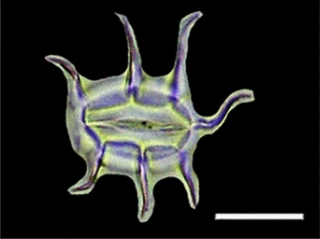
Back سيليكا النبات Arabic Fitòlit Catalan Phytolith German Fitolito Esperanto Fitolito Spanish Fütoliit Estonian گیاسنگ Persian Phytolithe French פיטוליתים HE Fitoliti Italian
scale bars 20 μm
Phytoliths (from Greek, "plant stone") are rigid, microscopic structures made of silica, found in some plant tissues and persisting after the decay of the plant. These plants take up silica from the soil, whereupon it is deposited within different intracellular and extracellular structures of the plant. Phytoliths come in varying shapes and sizes. Although some use "phytolith" to refer to all mineral secretions by plants, it more commonly refers to siliceous plant remains. In contrast, mineralized calcium secretions in cacti are composed of calcium oxalates.[2]
The silica is absorbed in the form of monosilicic acid (Si(OH)4), and is carried by the plant's vascular system to the cell walls, cell lumen, and intercellular spaces. Depending on the plant taxa and soil condition, absorbed silica can range from 0.1% to 10% of the plant's total dry weight. When deposited, the silica replicates the structure of the cells, providing structural support to the plant. Phytoliths strengthen the plant against abiotic stressors such as salt runoff, metal toxicity, and extreme temperatures. Phytoliths can also protect the plant against biotic threats such as insects and fungal diseases.[3][4]
- ^ Ge, Yong; Lu, Houyuan; Wang, Can; Gao, Xing (2020). "Phytoliths in selected broad-leaved trees in China". Scientific Reports. 10 (1): 15577. Bibcode:2020NatSR..1015577G. doi:10.1038/s41598-020-72547-w. PMC 7512002. PMID 32968165.
- ^ Piperno, Dolores R. (2006). Phytoliths: A Comprehensive Guide for Archaeologists and Paleoecologists. AltaMira Press ISBN 0759103852.
- ^ Rajendiran et al., (2012).Role of phytolith occluded carbon of crop plants for enhancing soil carbon sequestration in agro-ecosystems. Current Science, 103(8), 911-920.
- ^ Epstein, Emanuel (1999). "Silicon". Annual Review of Plant Physiology and Plant Molecular Biology. 50 (1). Annual Reviews: 641–664. doi:10.1146/annurev.arplant.50.1.641. ISSN 1040-2519. PMID 15012222.
© MMXXIII Rich X Search. We shall prevail. All rights reserved. Rich X Search

